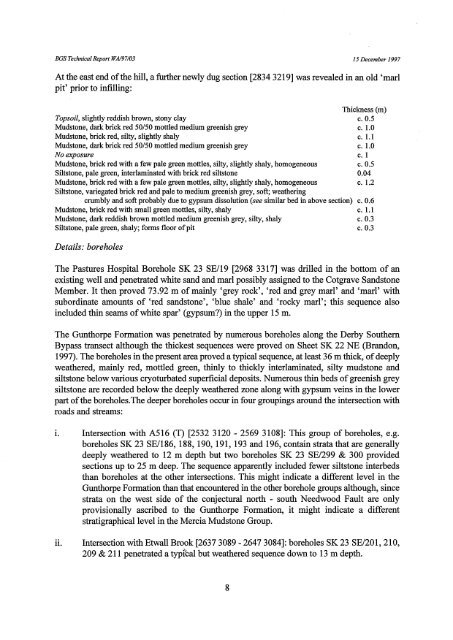Download (3723Kb) - NERC Open Research Archive - Natural ...
Download (3723Kb) - NERC Open Research Archive - Natural ...
Download (3723Kb) - NERC Open Research Archive - Natural ...
You also want an ePaper? Increase the reach of your titles
YUMPU automatically turns print PDFs into web optimized ePapers that Google loves.
BGS Technical Report WA/97/03 15 December 1997<br />
At the east end of the hill, a further newly dug section [2834 32191 was revealed in an old ‘marl<br />
pit’ prior to infilling:<br />
Topsoil, slightly reddish brown, stony clay<br />
Mudstone, dark brick red 50150 mottled medium greenish grey<br />
Mudstone, brick red, silty, slightly shaly<br />
Mudstone, dark brick red 50150 mottled medium greenish grey<br />
Thickness (m)<br />
c. 0.5<br />
c. 1.0<br />
c. 1.1<br />
c. 1.0<br />
No exposure c. 1<br />
Mudstone, brick red with a few pale green mottles, silty, slightly shaly, homogeneous c. 0.5<br />
Siltstone, pale green, interlaminated with brick red siltstone<br />
0.04<br />
Mudstone, brick red with a few pale green mottles, silty, slightly shaly, homogeneous c. 1.2<br />
Siltstone, variegated brick red and pale to medium greenish grey, soft; weathering<br />
crumbly and soft probably due to gypsum dissolution (see similar bed in above section) c. 0.6<br />
Mudstone, brick red with small green mottles, silty, shaly<br />
c. 1.1<br />
Mudstone, dark reddish brown mottled medium greenish grey, silty, shaly<br />
c. 0.3<br />
Siltstone, pale green, shaly; forms floor of pit<br />
c. 0.3<br />
Details: boreholes<br />
The Pastures Hospital Borehole SK 23 SEA9 [2968 33171 was drilled in the bottom of an<br />
existing well and penetrated white sand and marl possibly assigned to the Cotgrave Sandstone<br />
Member. It then proved 73.92 m of mainly ‘grey rock’, ‘red and grey marl’ and ‘marl’ with<br />
subordinate amounts of ‘red sandstone’, ‘blue shale’ and ‘rocky marl’; this sequence also<br />
included thin seams of white spar’ (gypsum?) in the upper 15 m.<br />
The Gunthorpe Formation was penetrated by numerous boreholes along the Derby Southern<br />
Bypass transect although the thickest sequences were proved on Sheet SK 22 NE (Brandon,<br />
1997). The boreholes in the present area proved a typical sequence, at least 36 m thick, of deeply<br />
weathered, mainly red, mottled green, thinly to thickly interlaminated, silty mudstone and<br />
siltstone below various cryoturbated superficial deposits. Numerous thin beds of greenish grey<br />
siltstone are recorded below the deeply weathered zone along with gypsum veins in the lower<br />
part of the boreholes.The deeper boreholes occur in four groupings around the intersection with<br />
roads and streams:<br />
1. Intersection with A516 (T) [2532 3120 - 2569 31081: This group of boreholes, e.g.<br />
boreholes SK 23 SE/186, 188, 190, 191, 193 and 196, contain strata that are generally<br />
deeply weathered to 12 m depth but two boreholes SK 23 SE/299 & 300 provided<br />
sections up to 25 m deep. The sequence apparently included fewer siltstone interbeds<br />
than boreholes at the other intersections. This might indicate a different level in the<br />
Gunthorpe Formation than that encountered in the other borehole groups although, since<br />
strata on the west side of the conjectural north - south Needwood Fault are only<br />
provisionally ascribed to the Gunthorpe Formation, it might indicate a different<br />
stratigraphical level in the Mercia Mudstone Group.<br />
..<br />
11. Intersection with Etwall Brook [2637 3089 - 2647 30841: boreholes SK 23 SE/201,210,<br />
209 & 21 1 penetrated a typihal but weathered sequence down to 13 m depth.<br />
8
















